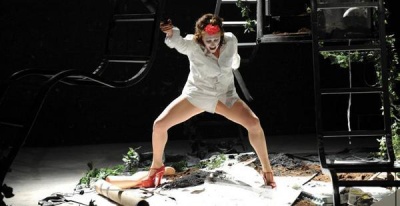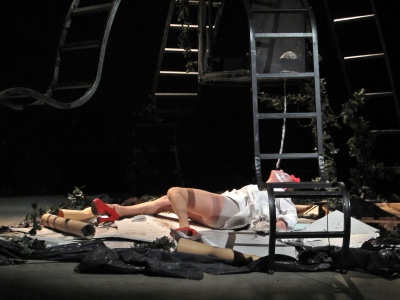Tal Beit Halachmi’s Dance of Shouts
 In her latest solo piece Progénitures (Offspring), Israeli dancer and choreographer Tal Beit Halachmi experimented with her voice and body. She struggled with herself in a space inspired by Maman spider structures by surrealist artist Louise Bourgeois, she was drowning in the text by Pierre Guyotat and searching for the borders between bearable/unbearable. And there were flies buzzing and buzzing all the time.
In her latest solo piece Progénitures (Offspring), Israeli dancer and choreographer Tal Beit Halachmi experimented with her voice and body. She struggled with herself in a space inspired by Maman spider structures by surrealist artist Louise Bourgeois, she was drowning in the text by Pierre Guyotat and searching for the borders between bearable/unbearable. And there were flies buzzing and buzzing all the time.Into the glare of a spotlight came a woman on high heels, neither slim nor stout, with half-length backcombed gray hair, squeezed in a tight corset and short suspenders. At first sight looking like Lady Macbeth before the finale. Breathing deeply in and out. Her voice was trembling, her body gently vibrating and the sensitive microphones fixed to her costume conveyed to the audiences every breath and exhalation, every sigh and cry. Tension in her body reflected the tension in the room, to which she passed Guyotat’s text about the violence and cruelty of the world, about warsand sex.
Author of the text, writer and playwright Pierre Guyotat occupies an important place in modern French literature. With her production, Tal Beit Halachmi once again proved that his texts are better heard than read. His reflections, statements, poetic images and symbols were in her interpretation indeed pliable. Words were hammering in dancer’s breath and body as well as in the space that surrounded her. Text resonated in the metal structure, which consisted of five variously deformed ladders and two central platforms, and gradually filled the whole theatre.
Tal Beit Halachmi relied on the significant power of language. The basic pillars of her production were intense utterances, framed by gestures and by movement in a defined place. Performer modified her voice in various ways, in her singing she took inspiration from a catholic church, a mosque, from the viscera and the fundamentalhuman manifestations. For instance, she was lying on the ground with a microphone in her throat, hanging from a platform. A spectator thus heard things otherwise inaudible, accompanied by the appellative, complex, dense and difficult text of the dramatist. Or she let some clay fall on her, in which she then rolled, rubbed it over her body and eventually sat in it. She climbed the red painted ladders to get to the
 platforms, she was hanging from them or tangled her body around them. Metal structure was also used to amplify rhythms and intensify the tension. As she sat huddled behind metal bars on the rest of the soil, she looked like awretched animal locked in a cage. Movements did not followthe words or double their meaning, but rather extended their significance. Her movement vocabulary therefore seemed much more brutal and vulgar than the text. She groped herself, some positions and movements were almost obscene and animalistic, yet her body still retained some pride and superiority about its means of expression.
platforms, she was hanging from them or tangled her body around them. Metal structure was also used to amplify rhythms and intensify the tension. As she sat huddled behind metal bars on the rest of the soil, she looked like awretched animal locked in a cage. Movements did not followthe words or double their meaning, but rather extended their significance. Her movement vocabulary therefore seemed much more brutal and vulgar than the text. She groped herself, some positions and movements were almost obscene and animalistic, yet her body still retained some pride and superiority about its means of expression.As one of the props the artist used a skull, which she stuck towards the end of the performance on a pole overgrown with ivy and let it "glow" in the glare of the spotlight. The question is, why she suddenly used such a cliche in the world of symbols and images. It can be said that the production is based on the aesthetics of death, cruelty, on sexuality and abomination. Israeli choreographer drew on the prehistory, the universe, the man.
The dancer undoubtedly succeeded in maintaining tension throughout the performance. Despite some rather shocking images she created around her an impenetrable bubble full of questions and important messages and did not let the spectator take away his eyes from her. Overall the performance left a very strong impression, although it might be worth consideration to what extent it is feasible with such a type of production to either play down or significantly emphasize movement at the expense of the text.
Written from the performance on February 16th, 2013, Théâtre de la Bastille, Paris
The concept and interpretation: Tal Beit Halachmi
Text Progénitures/Offspring: Pierre Guyotat
Lighting design: Françoise Michel
Sound engineer: Jonathan Merlin
Photo: Pascal Vanneau
Production: Talita Koumi association
Co-production: la Filature - scène nationale de Mulhouse, Parc de la Villette dans le cadre des Résidences d'artistes - Paris, Centre National de Chorégraphique Tours, Emmetrop - Bourges
Execution: Théâtre de la Bastille
With the support of la DRAC Centre, la Région Centre et l'ARCADI ainsi que la Mairie de Tours, L'Escale, Saint-Cyr-sur-Loire et Espace Ligéria, Montlouis-sur-Loire
Premiere: January 16th, 2013, Nadir


